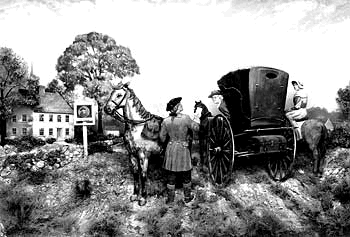
Transport

Horses were used as pack animals before they were either driven or
ridden. The commerce of the Roman Empire depended on pack-trains, as it
did throughout Europe in medieval times. In the 1690s a regular pack-horse
goods service ran between Exeter and London, England, but by 1830 only peddlers
had pack-horses and used them.
The first private coaches were expensive, cumbersome and
strictly for the aristocracy. Although they had a luxurious interior the
whole structure rested on solid beams and jerked and bounded over the rough
roads drawn by four great horses. The nobility were sometimes conveyed in
ornamental pole-slung litters, supported fore and aft by shaft horses.
The 17th century brought stagecoaches, but since springs were
not invented until the beginning of the 18th century, most people still traveled
on horseback.
In Britain until the regular stage and mail coach services of
1786, the mail was carried by horn-blowing, "spatterdashed" (top-booted)
horsemen. They were restricted to a top speed of 7 m.p.h. unlike the relay
riders, stationed at approximately 15-mile intervals, of the short-lived (18
months beginning April 1860) Pony Express, who galloped the mails across America.
The departure of the dashing mail coach, with its quality
horses, was one of the famous sights of London; but with the arrival of the
railroads the coaching era came to an end. However, the urban streets
continued to resound with the clatter of horse-drawn vehicles, buses,
four-wheeled "Growlers" and Hansom Cabs, swaying fire-engines dashing by at the
gallop and the elegant carriages of the gentry. With the arrival of the
automobile, the horse-drawn vehicle gradually disappeared in North America as
well as in Europe.
The covered wagons of the Boers and American settlers made
possible the opening up of their vast countries. The almost indestructible
Concord coaches, built by an American, not only established communications in
the undeveloped West, but did the same for South
Africa and Australia.
Since man first learned to ride, riding horses have provided transport in every
part of the world.
The boat-shaped covered wagon usually associated with the American frontier actually saw far more use on the east coast, hauling produce from the Pennsylvania Dutch farms of Lancaster County to Philadelphia. Conestoga drivers were tough on the road but gentle with their horses, said to descend from a Flemish breed introduced by William Penn, and were not ashamed to adorn their forelocks and bridles with ribbons and rosettes. Over the horses they hung hoops with bells on them, all with different chimes. These bells were the stiff price they had to pay for a helping hand if their wagon got stuck, so each driver looked forward to reaching his destination "with bells on."
Horses were also the main means of transport for people. As better roads
began to be built in the 19th century, and the art of carriage-making reached
its highest standards, coaches became lighter and faster, and very elegant
horses, such as Trotters and Hackneys,
were in demand to pull them.
Horse-drawn buses were once a common sight. Animals
used for public transportation, unlike the carriage-horses of the wealthy, often
led a hard life, working on slippery cobbled streets.
With the arrival first of the railways and then the motor
car, the horse was no longer needed for transport or agricultural work and it
looked as if many of the draft breeds might die out. However, businesses
are now (1990) realizing that, for short trips, horses are more economical for
deliveries than motorized vans, and are beginning to use them.
Although horses are no longer needed in most countries for
farming and transportation, several of the draft breeds from the heyday of the
working horse have survived, and are valued for their own sakes. They are
used for demonstrations and showing, and in a small way for work.